written and photographed by Mary L. Peachin
Jun 2001, Vol. 5 No. 8
 Devote Moslems, many of the Sunni sect, kneel as they ascend the ancient rocky stairs of the mausoleum Shah-I-Zinda. They will recite chapters of the Koran forty times as they make three steep climbs. During the pilgrimage to this sacred site in Samarkand, Uzbekistan, men and women display their devotion to Allah by wearing colorful head coverings—for men brightly embroidered skullcaps (dupalars). Women wear elegant silk headscarves that frame their faces.
Devote Moslems, many of the Sunni sect, kneel as they ascend the ancient rocky stairs of the mausoleum Shah-I-Zinda. They will recite chapters of the Koran forty times as they make three steep climbs. During the pilgrimage to this sacred site in Samarkand, Uzbekistan, men and women display their devotion to Allah by wearing colorful head coverings—for men brightly embroidered skullcaps (dupalars). Women wear elegant silk headscarves that frame their faces.
After paying homage to Allah, the pilgrims will head to the nearby graveyard (built between 1399 and1404), where they will place red carnations on family tombstones, memorializing their dead with prayers and chants. The pilgrimage in Samarkand to Shah-I-Zinda usually occurs 70 days after the celebration of Ruza Khart, the final day of Ramadan, or the breaking of the fast.
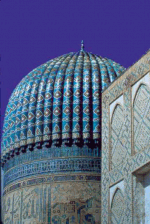 The majority of Uzbeks are Sunni Moslems, a sect who strictly adheres to the teachings of Mohammed. Calls to prayer echo throughout the blue mosaic, domed city five times daily. While many Uzbek Muslims do make the pilgrimage to Mecca, they claim that two trips to Shah-I-Zinda are equal in the eyes of Allah.
The majority of Uzbeks are Sunni Moslems, a sect who strictly adheres to the teachings of Mohammed. Calls to prayer echo throughout the blue mosaic, domed city five times daily. While many Uzbek Muslims do make the pilgrimage to Mecca, they claim that two trips to Shah-I-Zinda are equal in the eyes of Allah.
A city with a distinguished history, Samarkand, lies in the verdant green Ferghana Valley, which is surrounded by the stunning snow-covered peaks of the Tien Shan mountain range edge. Turkmenistan, Kazakhstan, Kyrgystan, and Tajikistan, are neighboring countries that also gained their independence when the Soviet Union crumbled September 30, 1991.
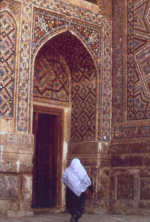 History buffs may remember Samarkand as the midpoint of the Silk Road between Europe and China (now called Tashkent Road), a destination for camel caravans traveling between China and Central Asia.
History buffs may remember Samarkand as the midpoint of the Silk Road between Europe and China (now called Tashkent Road), a destination for camel caravans traveling between China and Central Asia.
Others might know this city, in its gorgeous setting, as the domain of Alexander the Great. In the fourth century, Alexander, after marrying a local chieftain’s daughter, made Samarkand his capital, introducing Hellenic culture to the region. It was during this period that Samarkand, along with the Uzbekistan cities of Bukhara and Khiva, became an important link along the Silk Road. Around 700 BC, the arrival of Arab culture brought both Islam and a new alphabet. A century later, Persians conquered the area, launching a religious, cultural, and commercial renaissance in nearby Bukhara.
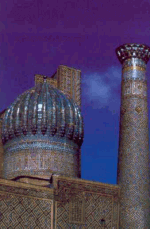 In 1212, Genghis Khan swept through with his Mongol warriors, plundering the cities along the Silk Road. Samarkand eventually rebuilt, and in 1370, Central Asia became centralized under the rule of 34-year-old Tamerlane (Timur the Lame), who inherited the name after being wounded by an arrow. He made Samarkand into a glittering capital, the cultural and economic hub of Central Asia. Tamerlane’s grandson, Uleg Beg, brought science to the city, creating the world’s first observatory.
In 1212, Genghis Khan swept through with his Mongol warriors, plundering the cities along the Silk Road. Samarkand eventually rebuilt, and in 1370, Central Asia became centralized under the rule of 34-year-old Tamerlane (Timur the Lame), who inherited the name after being wounded by an arrow. He made Samarkand into a glittering capital, the cultural and economic hub of Central Asia. Tamerlane’s grandson, Uleg Beg, brought science to the city, creating the world’s first observatory.
Despite this rich history, cities along the Silk Road declined as sea trade became popular. By the 19th century, the area became a strategic token in the political wrangling between Britain and Russia, which were locked in a continuous struggle for control of Central Asia. Russia emerged the winner and, after the revolution of 1917, divided Central Asia (then called Turkestan) into five republics, drawing arbitrary lines through ethnic areas, hunting grounds, and trade routes.
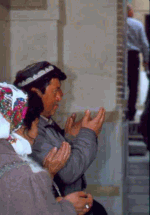 Uzbekistan became a Soviet Republic in 1923, and suffered under Russian domain, bearing the brunt of forced settlement and collectivization. Agriculture production was limited to the cotton needed by Russia’s textile factories. In the 1960s, water for cultivation of the arid region was diverted from the Aral Sea—leading to the devastating loss of the world’s fourth-largest body of fresh water.
Uzbekistan became a Soviet Republic in 1923, and suffered under Russian domain, bearing the brunt of forced settlement and collectivization. Agriculture production was limited to the cotton needed by Russia’s textile factories. In the 1960s, water for cultivation of the arid region was diverted from the Aral Sea—leading to the devastating loss of the world’s fourth-largest body of fresh water.
After the collapse of the Soviet Union in 1990, Uzbekistan declared its independence. Though it struggles to maintain political stability, its tumultuous history has created an incredible cultural heritage for Samarkand. There is unsurpassed drama in the skyline: the domes of mausoleums, mosques, and medressahs (Islamic seminaries) rise in every direction, covered in blue tile mosaic and gold leaf. Intricately carved wooden doors and arches lead mosque visitors to interiors made of fired brick, and filled with enormous, detailed mosaics.
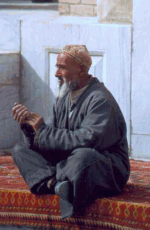 A British count once called Registan Square, the cultural centerpiece of Samarkand, “the noblest public square in the world.” Against an array of domed medressahs and mosques, dwarfed by tiled minarets (one tilting like the leaning tower of Pisa), women walk briskly to market, wearing brightly patterned silk dresses over silk pants, their hair pulled back under floral-patterned scarves.
A British count once called Registan Square, the cultural centerpiece of Samarkand, “the noblest public square in the world.” Against an array of domed medressahs and mosques, dwarfed by tiled minarets (one tilting like the leaning tower of Pisa), women walk briskly to market, wearing brightly patterned silk dresses over silk pants, their hair pulled back under floral-patterned scarves.
The spice-scented outdoor market is filled with vendors selling mint, saffron, apricots, onions, pistachios, almonds, sun-dried raisins, cumin, coriander, hot pepper, and rice pilaf. In summer, produce includes dried fruit, pomegranates, oranges, eggplant, cucumbers, berries, quince, peaches, grapes, and tomatoes. Other booths feature tobacco, cans of cooking oil and gas, and huge blocks of sugar. Clothing vendors congregate at one end of the market, selling dupalars and cloth material along with buttons and ribbons. Another area is devoted to stall after stall of rock candy. Old-fashioned scales with counterweights are used for pricing; it is difficult to spend more than a few dollars, as prices are extremely low by Western standards.
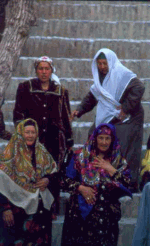 An entire extended family—including nine or ten children—lives in the typical Uzbek house. Men may be seen as patriarchs, but the women, including the grandmothers, make day-to-day household decisions. The youngest married son takes care of the aging parents, while his wife, who has the lowest status in the family, cleans the house.
An entire extended family—including nine or ten children—lives in the typical Uzbek house. Men may be seen as patriarchs, but the women, including the grandmothers, make day-to-day household decisions. The youngest married son takes care of the aging parents, while his wife, who has the lowest status in the family, cleans the house.
Uzbeks exude warmth, and they welcome travelers with enthusiasm. Men shake hands energetically, placing their left hand over their heart to express sincerity; women hug or kiss one another’s cheeks. Both men and women hold hands, join arms, or drape their arms over one another’s shoulders. But there is no public display of physical affection, or even eye contact, between men and women.
Uzbekistan is not a gourmet’s destination. Rice, potatoes, beets, and meat (usually mutton, but also beef, chicken, and rabbit) are the staples of Uzbek cuisine. Palov, the national dish, consists of meat braised with rice and carrots. Also popular is mante, dumplings with meat or vegetables. Finding the food a bit greasy for my taste, and wary about hygiene, I stuck to a diet of potato, beets, and nan during my visit. Nan, a flat round bread crusted with black sesame seeds, is considered sacred; scraps are never thrown away, left on the floor, or placed on the table facedown (such actions are believed to bring bad luck). As ice and cold drinks are believed to cause sore throats; Uzbeks always drink hot tea.
 Since the days when camel caravans passed through the city, silk carpets have been the treasure to buy in Samarkand. Also beautiful is the brightly colored traditional Uzbek cotton handwork: suzana (silk-on-cotton dowry needlework) and adreas (silk and cotton bedspreads). Many bazaars sell traditional clothing, including quilted coats, men’s embroidered knee-length jackets, skullcaps, and scarves. Bargaining is expected, but once a bargain is struck, the buyer is obligated.
Since the days when camel caravans passed through the city, silk carpets have been the treasure to buy in Samarkand. Also beautiful is the brightly colored traditional Uzbek cotton handwork: suzana (silk-on-cotton dowry needlework) and adreas (silk and cotton bedspreads). Many bazaars sell traditional clothing, including quilted coats, men’s embroidered knee-length jackets, skullcaps, and scarves. Bargaining is expected, but once a bargain is struck, the buyer is obligated.
But a visit to Uzbekistan is not for shopping, eating, or staying in luxurious accommodations. The focus of any visit to Samarkand is the Muslim culture, relatively undiscovered and untouched by Westerners, and the magnificent architecture. And the people—welcoming, curious, and helpful. Friendly greetings of, “Assalam alaikum” (peace be upon you) echo through the streets. With warmth in my heart I replied, again and again, “Vaalaikum assalam”—and peace also to you.
If you go:
Tour companies: TCS Expeditions, 1-800-727-7477 or travel@tcs-expeditions.com
Airlines: Lufthansa flies from Frankfurt to Samarkand.
Visas: U. S. Embassy, 1746 Massachusetts Ave., Washington D.C., 202-887-5300, fax 202-293-6804. Allow at least a month for visa processing.
Hotels: Hotel Samarkand runs about $40-50 a night. The Afrosiab Hotel is $70-80.
Guidebook: Uzbekistan, Odyssey Publications, 1999.
Money: Uzbek 0.90 is equal to $1.00 U.S.
Electrical current: 220V
